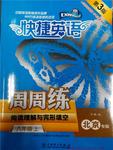题目内容
114. How ________ you to remember my birthday!
A. sweet for B. sweet of C. kind for D. nice for
B

 快捷英语周周练系列答案
快捷英语周周练系列答案If we agree that the function of education is to prepare us for life, then there is very little time to waste. So, while we can, we ought to concentrate on teaching children something really useful. Here is what our schools should teach.
Politeness is a mark of civilization. The sooner children learn this, the better. In any case, a lot can be accomplished by a smile and good manners.
Like it or not, our adult lives will be consumed by the struggle for money, but we don’t make an effort to teach children how to manage it. So our schools have a duty to teach them this ability from the beginning.
We’re likely to accept something we are told, but that’s not what educated people do. Educated people are reasonable and they look at facts. If our schools teach nothing else, they should at least teach critical(批判性的)thinking.
Children should learn to take care of their health. They should know that if they eat junk food, they will become fat and unhealthy. They should be very clear about what happens to their bodies when they drink or smoke.
All of us are part of society. We have rights and responsibilities. We ought to understand what they are. We have to know a little bit of history and geography, because we need to have an environment in which to relate to the people around us.
How will we test students on these? We can’t. But that’s not a reason to avoid teaching what is important. Our schools should spend every moment they have telling this to our children: ”This is life, this is what you are going to face, and this is how you deal with it.”
|
Title |
Very 1. In Schools |
|
Introduction |
Education should be a 2. for life. |
|
Advice |
Useful things should 3. in schools. |
|
Teaching 4. |
●How to behave 5. ●The basic skill of 6. money ●How to think in 7. ●How to 8. ●The rights and responsibilities one has in 9. |
|
Conclusion |
Children should be taught what life is and how to 10. it. |
With the new school year quickly coming near (or perhaps, for your early-starters, already under way), it’s time to get ready for a successful term(学期). And while you may be cleaning your wardrobe(壁柜), it’s equally important to freshen up(更新) your study skills, too.
Have you ever noticed that your study habits are different from those of your friends? Or how you seem to learn faster in certain classes? Some people are quick to blame(责备) the teacher or subject(学科) for their difficulties, but that isn’t always the cause(原因). One thing that many people seem to ignore(忽视) is their learning type.
Now, you may be wondering what a learning type is and how to find yours. There are three different learning types: Visual, Auditory, and Kinesthetic. You can be a combination of learning types, but most people have one main type.
1. Visual learners learn best by seeing. If you seem to easily get information from pictures, graphs, and videos, you are likely a visual learner.
2. Auditory learners learn best by hearing. If you seem to remember things by hearing them, whether listening to a lecture or repeating information out loud, then you are likely an auditory learner.
3. Kinesthetic learners learn best by doing. If you seem to learn best by working with your hands or testing out what you are shown, you are likely a kinesthetic learner.
So now that you know your personal learning style, the trick (窍门) is to find out how to use your new-found knowledge to help you in your classes.
1.According to the speaker, why are some students slower than others in a certain subject?
|
A.Because they find the subject too difficult. |
|
B.Because they have lost interest in the subject. |
|
C.Because their teacher is not good enough. |
|
D.Because they don’t know their learning type. |
2.Which of the following can best replace the underlined word “combination”?
|
A.success |
B.mixture |
C.wonder |
D.model |
3.Stephen loves science and usually does experiments with his classmates in the lab to test what he has learned. So what type of learner is he?
|
A.Visual |
B.Auditory |
C.Kinesthetic |
D.Both A and B |
4.What do you think the speaker is going to do next?
|
A.To give further explanation to the three types of learners. |
|
B.To give clear examples of the three types of learners. |
|
C.To make a survey(调查) about the three types of learners. |
|
D.To suggest different study skills to different types of learners. |